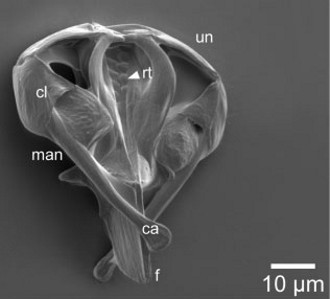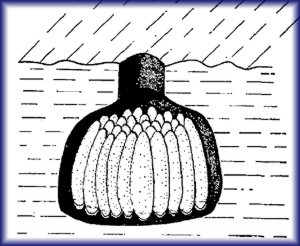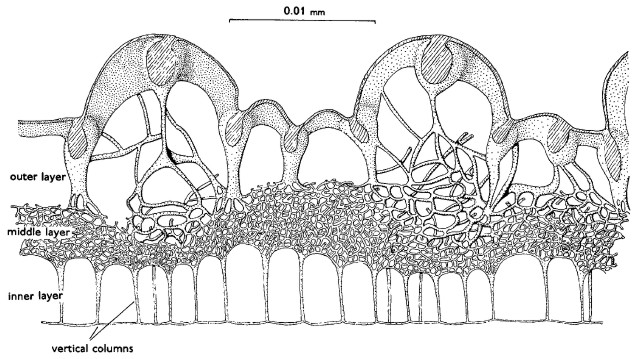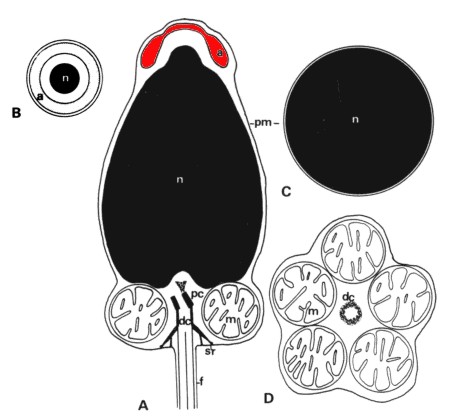|
Decreasing size, increasing intricacy
They may not look like brooms, but flies perform an invaluable service in helping to sweep the land clear of carcasses. Where would we be without them? Like many other animals, both vertebrate and invertebrate, they face a severe challenge to their survival early in life; their eggs can be subjected to wildly alternating periods of wet and dry. Take the egg mass of Orthellia caesareon pictured at top. Found in pockets in the surface of cow dung, the eggs can be quickly drowned when the clouds put on a temper tantrum. No rain, and they are, as they say, high and dry. What's the problem? Most developing embryos need free access to the atmosphere; they must be able to absorb oxygen from it and expel waste gases into it at all times. Eggs laid in places where conditions oscillate between wet and dry have to be able to cope with both. The quest to understand how gases are able to pass freely into and out of eggs under changing conditions has kept investigators busy for many decades.
Since the arrival of the first electron microscope in 1942, researchers have thoroughly enjoyed themselves resolving the marvels and mysteries of eggshells. Their discoveries have confirmed one of the most all-pervading themes of living things - survival depends not on the ability to outcompete other creatures but on spectacularly intricate design and superb engineering. More than any other invention, the electron microscope has underscored the pervasiveness of this truism even down to the smallest of scales, the realm of "ultrastructure" or "fine structure" and, in the process, has opened up another dimension in our understanding of the capabilities of God. He not only has mastery over the unimaginably large, His powers of craftsmanship extend down into the no-man's-land of tininess. In the world revealed by the EM (electron microscope), every tiny part is perfectly shaped and utterly precisely positioned; it has to be or the system won't work and the creature it is found in would quickly perish. We are talking here about scales of size that you and I have difficulty grasping. Ultrastructure's chief unit of measurement is the micron, which is one thousandth of a millimeter. In the case of many insect eggs, measurements are given in Angstrom units. One micron equals ten thousand angstroms. Eggshells are pitted with pores (aeropyles) just big enough to facilitate the traffic of gas molecules. God not only sees things that size, He operates with complete ease down there. He made it all.
The chorion, or outer layer, of insect eggs is admirably designed to perform the dual purposes of permitting the exchange of gases while preventing drowning when immersed. The challenge involved is highlighted by a simple fact:
Because the oxygen molecule is larger than the water molecule, no animal has been able to evolve a membrane that is at once permeable to oxygen and impermeable to water (Hinton 1969, Respiratory Systems of Insect Egg Shells, Annual Review of Entomology).
The same problem applies to eggshells. The structure of the chorion has physical properties - intelligently designed -
|
that resist wetting when immersed and lead to the formation of an ultra-thin (about ten microns) air shell, known as a plastron, surrounding the egg that stops the water from penetrating the egg. Gases can dissolve into and out of the plastron from the surrounding water. Needless to say, the variations on the basic theme of chorion construction (see differences between figs. 1 & 2) is mind-blowing, demonstrating yet again the endless genius of the Creator. However - and this is critical to understand - every single design works. The potential for inefficient, unworkable design based on the same general concept is truly infinite. Divinely-contrived designs all work perfectly.
Brilliant design at the ultrastructural level pervades every nook and cranny of life. Rough enough is never good enough at the smallest of scales. As a rule, the further down into the scale of anatomy you drill, the more remarkable the level of the Creator's attention to design detail. If the overall form of a tiger excites you, the intricacy of a rotifer's mastax ought to make you fair swoon. Rotifers are microscopic multi-celled organisms that are characterized by a complex set of jaw elements in the pharynx. Each species sports a different mastax model, each one perfectly suited to the food and method of feeding of that species. Note the scale bar in the picture. Ten microns equal 1/100th millimeter! You and I haven't a hope of seeing a mastax with the naked eye, yet it must be precisely engineered or good-bye rotifer.

Do a Google Scholar search on "ultrastructure spermatozoa" and you will be presented with over 29,000 articles for your delectation! Animal sperm, you see, is not only highly variable in structure between species, it is dazzlingly complex in its fine structure. For a brief overview, why not peruse the pdf file "A Comparative View of Sperm Ultrastructure". As this article says (written in 1970, and thus maybe now outdated), biologists are "still unable to account for the species variations in form and volume of the acrosome" (section in red in Fig. 3). God can. If you find yourself swept off your feet by the topic (and why not?!), you might wish to consider buying the book "The Ultrastructure and Phylogeny of Insect Spermatozoa". To God be the glory, staggering things He has done. |








